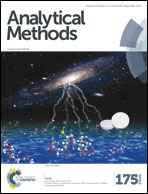A polyaniline/graphene oxide nanocomposite as a voltammetric sensor for electroanalytical detection of clonazepam
Abstract
A voltammetric sensor based on a polyaniline/graphene oxide modified glassy carbon electrode (PANI/GRO/GCE) has been developed for the ultrasensitive voltammetric detection of clonazepam (CZPM). The synthetic PANI/GRO nanocomposite along with its precursors PANI and GRO has been characterized by various spectral techniques like infrared and Raman spectroscopy, scanning electron microscopy (SEM), electrochemical impedance spectroscopy (EIS) and voltammetric techniques like square wave and cyclic voltammetry. Under optimized conditions, the PANI/GRO/GCE showed a well-defined reduction peak in Britton–Robinson buffer at pH 8.8 in ethyl alcohol. The square wave cathodic current exhibits a linear response to clonazepam over a concentration range of 10 (ng mL−1) to 550 (ng mL−1) with a correlation coefficient (r2) of 0.9935, a detection limit (LOD) 4.63 ng mL−1 and a quantification limit (LOQ) 15.44 ng mL−1. The proposed method for quantification of CZPM demonstrates the enhanced catalytic response of the PANI/GRO/GCE with a reproducibility of 4.21% relative standard deviation (RSD) and a satisfactory recovery from 97.16% to 102.78%.


 Please wait while we load your content...
Please wait while we load your content...